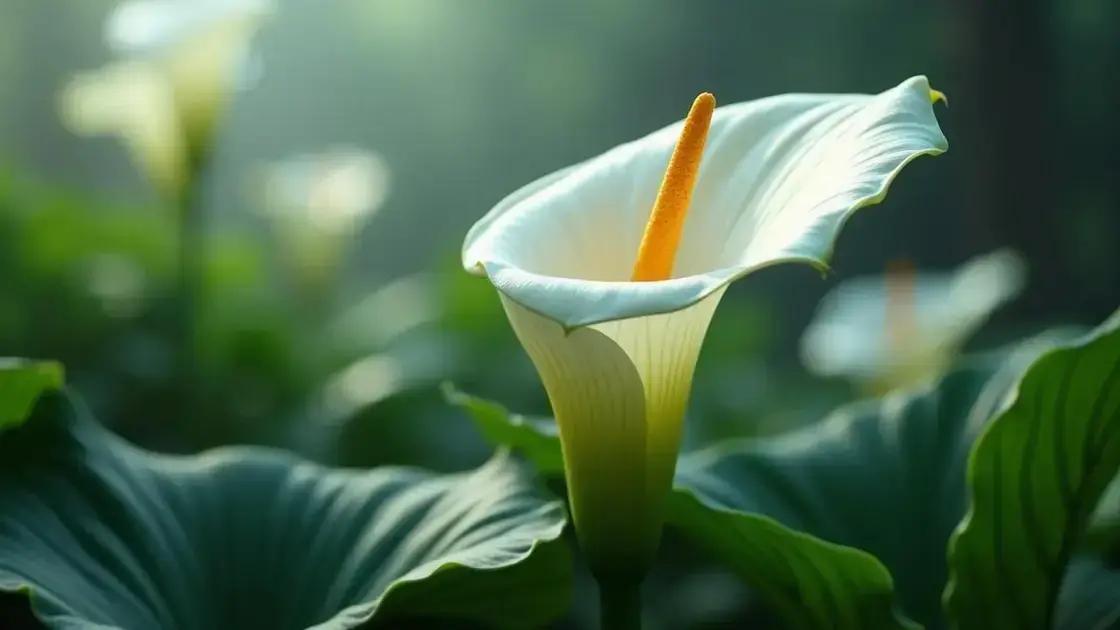How to Care for a Calla Lily Plant: 5 Essential Tips for Success
How to care for a calla lily plant can be a delightful journey for any gardening enthusiast. Discover how these stunning blooms can transform your space into a vibrant display of color and life. With proper care, these elegant flowers can enhance your garden or home seamlessly. Curious about the best methods to achieve flourishing calla lilies? Let’s uncover the essentials together.
Table of Contents
ToggleWatering techniques for healthy calla lilies
Watering techniques for healthy calla lilies begin with understanding their unique water requirements. Proper hydration is crucial for the growth and resilience of these elegant plants. Here’s how you can ensure your calla lilies receive the right amount of water for optimal health.
Understanding calla lily water needs
Calla lilies thrive in consistently moist soil but detest being waterlogged. Here are some key points:
- Frequency: Water your calla lilies regularly, allowing the top inch of soil to dry out between waterings.
- Method: Water at the base of the plant to avoid wetting the leaves, which can lead to fungal diseases.
- Drainage: Always use well-draining pots or garden beds to improve drainage and prevent water accumulation.
Seasonal watering adjustments
Your watering routine should adapt to seasonal changes:
- Spring to summer: Increase watering frequency as temperatures rise and plants actively grow.
- Fall: Gradually reduce watering as the plant enters a dormant phase.
- Winter: Water less frequently, keeping soil slightly moist but not wet.
Signs of improper watering
Monitor your calla lilies for these signs:
| Symptoms | Causes |
|---|---|
| Yellowing leaves | Overwatering or poor drainage |
| Wilting | Underwatering or drought stress |
| Brown leaf tips | Low humidity or underwatering |
By paying attention to these signs, you can adjust your watering techniques accordingly. For those interested in exploring indoor gardening techniques, understanding the water needs of your plants will enhance your success.
Frequently asked questions about watering calla lilies
Here are a few concise answers to common questions that may help you:
- How often should I water? Water once the top inch of soil feels dry.
- Can I use tap water? Yes, but let it sit for 24 hours to allow chlorine to dissipate.
By applying these watering techniques, your calla lilies will flourish, bringing beauty to your indoor or outdoor space.
Soil requirements for thriving calla lily plants

Soil requirements for thriving calla lily plants are essential for their health and growth. Providing the right soil type ensures these beautiful flowers flourish. Here’s what you need to know about creating the optimal environment for your calla lilies.
Ideal soil composition for calla lilies
To support robust growth, focus on these key soil attributes:
- Well-draining: Calla lilies prefer soil that drains well to prevent root rot. A mix of potting soil, perlite, and coarse sand works best.
- Organic matter: Incorporating compost enriches the soil, providing necessary nutrients.
- Acidity: Aim for slightly acidic to neutral pH, ideally between 6.0 and 7.0.
Steps to prepare the perfect soil
Follow these steps to prepare soil that meets the needs of your calla lilies:
- Choose a quality potting mix designed for flowering plants.
- Add perlite or coarse sand to improve drainage.
- Mix in well-rotted compost to enhance nutrient content.
- Test the pH to ensure it falls within the ideal range.
Monitoring soil health
Regularly assess your soil conditions to ensure optimal health for your calla lilies:
| Indicator | Action |
|---|---|
| Soil compactness | Loosen soil if it feels hard to allow water penetration. |
| Color | Dark soils indicate richness; amend with compost if light. |
| Drainage | Check after watering; adjust components if water pools. |
For those interested in exploring indoor gardening techniques, understanding the soil requirements will help you nurture thriving calla lilies in your collection.
Frequently asked questions about calla lily soil
Here are concise answers to common questions regarding soil requirements:
- What type of soil is best? Use a well-draining potting mix enriched with organic matter.
- How often should I test soil pH? Check every 6-12 months to maintain optimal conditions.
By providing the right soil mix, your calla lilies will flourish, creating visually stunning displays in your home or garden.
Identifying pests and solutions for calla lilies
Identifying pests and solutions for calla lilies is vital for maintaining healthy plants. These beautiful blooms can fall victim to various pests, but early detection and intervention can save your callas from significant damage.
Common pests affecting calla lilies
Being aware of potential threats can help you prevent infestations. Here are some common pests that target calla lilies:
- Aphids: Small, soft-bodied insects that suck plant sap, leading to wilting or yellowing leaves.
- Spider mites: Tiny pests that create fine webbing and cause leaf discoloration. They thrive in dry conditions.
- Mealybugs: White, cottony pests that cluster on stems and leaves, causing stress to the plant.
- Fungus gnats: Small flies that breed in overly moist soil, harmful mainly at the larval stage.
Effective solutions for pest control
Implementing effective pest management strategies can protect your calla lilies. Consider these solutions:
- Natural insecticides: Use neem oil or insecticidal soap to combat soft-bodied insects.
- Water sprays: A strong water spray can dislodge pests like aphids and spider mites.
- Sticky traps: Place yellow sticky traps around your plants to catch flying insects.
- Remove affected leaves: Regularly inspect and prune away infested parts to prevent the spread.
Recognizing the signs of pest damage
Monitoring your calla lilies for signs of pests is crucial:
| Damage Type | Symptoms | Action |
|---|---|---|
| Wilting | Leaves droop or yellow from sap loss | Check for aphids or spider mites |
| Webbing | Fine strands on leaves indicate spider mite presence | Apply neem oil and increase humidity |
| White residue | Cottony masses on leaves signal mealybug infestations | Use natural insecticide to remove |
For those keen on exploring indoor gardening techniques, understanding pest management will ensure your calla lilies flourish within your indoor oasis.
Frequently asked questions about pests on calla lilies
Here are quick responses to common pest-related inquiries:
- How can I keep pests away? Maintain proper watering and humidity levels to discourage pest infestations.
- What should I do if I find mealybugs? Remove them with a cotton swab dipped in alcohol.
By proactively identifying pests and applying effective solutions, you can uphold the beauty and vitality of your calla lilies.
In conclusion
Caring for calla lilies is an engaging and rewarding experience that enriches your gardening journey. By mastering essential aspects such as watering techniques, soil requirements, and pest management, you set the stage for stunning blooms and healthy growth. With proper care, your calla lilies will not only enhance your space but also bring joy to your gardening endeavors. For more inspiration, check out these tips on enhancing your indoor garden.

